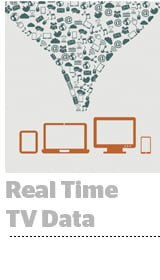 Television remains the world’s most powerful medium both in terms of time spent and ad investment, but the way people use it has changed. Writing recently in an article for the Atlantic, Derek Thompson noted, “The trouble with the TV business is that even though more people than ever are paying for TV—whether it’s on cable, satellite/telco, Netflix, Hulu Plus, or Amazon Prime Video—fewer people are watching it live. Broadcast TV ads are sold against live audiences. Without live audiences, advertisers go away.”
Television remains the world’s most powerful medium both in terms of time spent and ad investment, but the way people use it has changed. Writing recently in an article for the Atlantic, Derek Thompson noted, “The trouble with the TV business is that even though more people than ever are paying for TV—whether it’s on cable, satellite/telco, Netflix, Hulu Plus, or Amazon Prime Video—fewer people are watching it live. Broadcast TV ads are sold against live audiences. Without live audiences, advertisers go away.”
One company that seeks to bridge the growing gap between online, mobile and broadcast advertising is TVTY. Founded in 2008 by Eliott Reilhac and Pierre Marechal, and backed by VC firm Partech Ventures, TVTY syncs online campaigns with TV advertising in real time.
CEO Reilhac explained TVTY’s approach saying, “The problem that we solve is double-sided. For TV buyers, we allow them to increase their reach with the online inventory. For trading desks and ad networks, we allow them to reach branding budgets which are higher and with higher CPMs. We increase their turnover with better margins and with new budgets.”
TVTY’s equipment triggers campaigns within the DSPs and ad servers they are connected to. It uses a video fingerprinting technology that compares TV frames to identical frames within TVTY’s database. At this rate, it takes 200 milliseconds from the start of a television ad for TVTY’s technology to recognize it.
Once detected, the tech can then trigger the same ad on mobile and online screens. This is advantageous to advertisers, as it helps boost campaigns across multiple platforms in real time. The system can also trigger attack ads. For example, a campaign online can be triggered as soon as a competitor’s campaign is detected on TV.
One client to integrate TVTY’s technology is Amnet, Dentus’s programmatic buying arm, and the company has tested TVTY’s technology for travel, automotive and pharmaceutical campaigns. General manager Marie Le Guével explained the importance of multi-screen strategies.
“For a growing number of our clients we manage all usual types of digital campaigns, from pure branding to traffic generation and direct-response campaigns,” Le Guével said. “But most interestingly, we manage them through a multi-screen approach (desktop, mobile, tablet, IPTV) and integrate them to our clients’ global actions, CRM for instance – which is now made possible through the creation of DMPs.”
“We have connected [TVTY’s] technology to our DSPs. This way, TVTY simply sends us the technical signal we need, to be able to activate and pause a campaign,” she added.
In a report published last year by the IAB, Forrester detailed, “Online video is a new medium that is living through a meteoric rise. From traditional video sources like broadcast networks to video content on news and sports sites and user-created content, the volume and diversity of online video has grown noticeably. Even over the past 12 months.”
TVTY is not the only firm working to support synchronization of TV spots with digital ads. Companies such as WyWy and Civolution offer similar solutions that seek to align with current marketing trends. All three of these companies are expanding globally, and it seems that revenue growth is also on the rise.
According to Tobias Schmidt, CEO of WyWy, the company has been growing at double-digit rates month to month since they began selling their products in Q3 2013. It has executed more than 20 campaigns for customers such as Vodafone, HTC and Hyundai and are working with agencies and trading desks such as GroupM, Omnicom, Aegis and Havas.
“Extending the reach and effectiveness of TV campaigns through complementary programmatic multiscreen advertising is in high demand by brands and their agencies alike. The challenge is being a leading player in 2 disciplines at the same time: real-time broadcast detection and real-time advertising,” said Schmidt.












